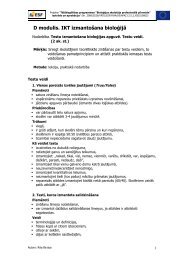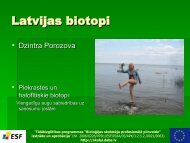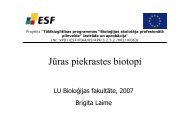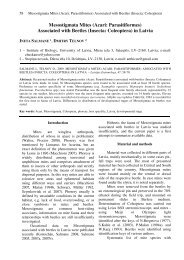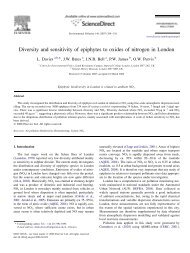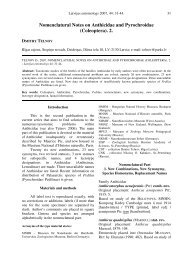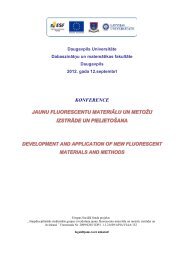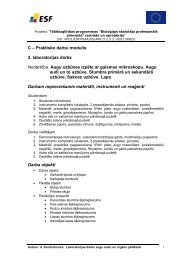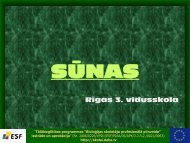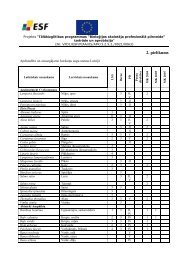download - Entomological Society of Latvia - Latvijas Daba
download - Entomological Society of Latvia - Latvijas Daba
download - Entomological Society of Latvia - Latvijas Daba
You also want an ePaper? Increase the reach of your titles
YUMPU automatically turns print PDFs into web optimized ePapers that Google loves.
<strong>Latvijas</strong> Entomologs 2012, 51: 40-57. 41Pollution and overgrowth <strong>of</strong> habitatsalso may threaten the survival <strong>of</strong> thisspecies. Therefore, A. subarcticahas been classified as Least Concern(LC) species in the European RedList <strong>of</strong> Dragonflies (Kalkman et al.2010), and in the European Unionalso as Least Concern species withthe decreasing population trend(Kalkman et al. 2010).The aim <strong>of</strong> this paper is tosummarize the knowledge <strong>of</strong>the distribution and habitats <strong>of</strong>A. subarctica in <strong>Latvia</strong>. This dragonflyis not protected in <strong>Latvia</strong>, but so farthe data on it have not been analysedand the species’ current populationstatus has not been assessed.MethodsThe analysis <strong>of</strong> distributionand habitat preference is based on:(a) all published data, (b) author’sunpublished data collected between1999 and 2010, (c) unpublished datacollected by entomologists before2011. Both historical and recent data,in total 31 records <strong>of</strong> A. subarctica,were included in a Micros<strong>of</strong>t OfficeAccess geodatabase prepared by theauthor.The distribution <strong>of</strong> A. subarcticahas been mapped using a basic grid<strong>of</strong> 5x5 km squares in the Baltic gridsystem on a Transverse Mercatorprojection (TKS-1993) <strong>of</strong> <strong>Latvia</strong>. Thefinal map is based on 1:50000 scalesatellite maps available for <strong>Latvia</strong>,published in 1999–2000 by the StateLand Service <strong>of</strong> the Republic <strong>of</strong><strong>Latvia</strong>.The data on habitats (inter aliaphoto) were collected by the authorand others in the field. Potentialhabitats, such as raised bogs withbog pools and lakes, lakes withinfens and bogs and post-excavationpeat bogs were examined. Visualsearch for imagines and exuviaewas made. Egg laying microhabitatand substratum was registered whenegg-laying females observed. Dataon particularly protected natureterritories come from the website<strong>of</strong> the Nature Conservation Agency(Nature Conservation… 2011).The quantitative field dataon dragonflies exuviae in LielaisĶemeru tīrelis Bog were collected in16 sampling plots on 16 and 19 July2007. The survey <strong>of</strong> dragonflies andthe evaluation <strong>of</strong> vegetation werecarried out within a 100 m long anda 5 m wide transect in each samplingplot. The percentage <strong>of</strong> the coverage <strong>of</strong>different vegetation forms, the impact<strong>of</strong> trees, the dragonfly species and thenumber <strong>of</strong> individuals were evaluatedin each 20 metres in the transect. Thehabitat groups were chosen for thearrangement <strong>of</strong> sampling plots bymaps at the landscape level, choosing
42 The ecology and conservation <strong>of</strong> the Bog Hawker Aeshna subarctica ...the most typical habitats, but transectswere chosen by ten categories <strong>of</strong>vegetation developed by the author’sand as well as by accident. Eachtransect was run through two times,i.e. back and forth and all exuviaewere collected.The quantitative field data ondragonflies imago were collected inGrabatiņš Lake and Meistars Lake.The survey <strong>of</strong> dragonflies werecarried out within a transect alonglake bank. All observed specimenswere counted. The length <strong>of</strong> bank <strong>of</strong>Grabatiņš Lake is 300 m, <strong>of</strong> MeistarsLake is 550 m.The areas measured onorthophoto maps, scale 1:10 000 fromthe third cycle (2007-2008) <strong>of</strong> aerialphotography (<strong>Latvia</strong>n GeospatialInformation agency) using Arc GIS9 s<strong>of</strong>tware. Geographical coordinatesare only given for several localities,localisation <strong>of</strong> which could bedifficult. Vegetation descriptionsconcern a zone inhabited byA. subarctica.Explanations <strong>of</strong> abbreviations: Aessub– Aeshna subarctica, PPNT – particularlyprotected nature territory, d. – district, vill. –village. The number <strong>of</strong> observed imagines orcollected exuviae <strong>of</strong> A. subarctica (Aessub)is given after the date <strong>of</strong> observation andfollowed by references or the author <strong>of</strong>unpublished data, as e.g. (M. Kalniņš). Theregions are named according to the Lawon administrative territories and populatedareas (2008). Some <strong>of</strong> the regional namesare concurrent with district names, used bythe author in previous papers (Kalniņš 2007,2008).ResultsTwenty one locality <strong>of</strong>A. subarctica has been recordedin <strong>Latvia</strong> so far. Geographicalcoordinates are only given forseveral localities, localisation <strong>of</strong>which could be difficult. Vegetationdescriptions concern a zone inhabitedby A. subarctica.1. Lielauce Lake (Auced.). August <strong>of</strong> 1949, Aessub: 1female was caught (Spuris 1952;1956). Information about locality(vegetation) was not described indetail in the original publication, thedata on vegetation concern its currentcomposition. The lake is large andrich in diverse habitats and one part<strong>of</strong> lake are fen (~200 ha). The localityhas had PPNT status since 1999. It issituated in the nature reserve “Vīķupurvs” and in the NATURA 2000 area(site code: LV0504700).2. Complex <strong>of</strong> bog pools S <strong>of</strong>Gārgaļu Lake and at the NE part <strong>of</strong>large Lielais Ķemeru tīrelis Bog(Tukums d.). Large (~5000 ha)active raised bog with largecomplexes <strong>of</strong> bog pools. Vegetationwith Sphagnum cuspidatum andSphagnum sp., Eriophorum sp.,
<strong>Latvijas</strong> Entomologs 2012, 51: 40-57. 43Rhynchospora alba, Scheuchzeriapalustris, Ledum palustre, Vacciniumuliginosum, Calluna vulgaris andAndromeda polifolia (Table 1).06.08.2003, Aessub: 1 female caught(M. Kalniņš); 18.07.2007, Aessub: 11exuviae near five bog pools (Table1) (M. Kalniņš) (Kalniņš, Medne2007). Since 2006 a project for therestoration <strong>of</strong> the bog’s hydrologicalregime – earlier seriously disturbeddue to drainage – has been carried outresulting in an increased water levelthat will certainly improve the habitatconditions for A. subarctica (Ķuze,Priede 2008). The locality has hadPPNT status since 1973. It is situatedin the Ķemeri National Park and inthe NATURA 2000 area (site code:LV0200200).3. Pakujezers Lake nearEzerkalni (Baldone d.). Adyseutrophic lake (~1 ha), borderedby a wide (5–10 m) Sphagnumzone with Sphagnum cuspidatum,Carex limosa, Eriophorum sp.,Rhynchospora alba, Calluna vulgarisand Andromeda polifolia. 01.06.2008,Aessub: 1 exuviae (M. Kalniņš).4. Sudas Bog, SE part, SEfrom Velna Lake env. near smallbog pool (Līgatne d.). 17.06.2006,Aessub: 2 exuviae (M. Kalniņš);Sudas Bog, Central part, Salas Lakeenv. near small bog pool 19.06.2006,Aessub: 1 individual (M. Medne);Large (~2600 ha) active raised bogwith numerous bog pools and smalllakes. Vegetation with Sphagnumcuspidatum and Sphagnum sp.,Eriophorum sp., Rhynchosporaalba, Scheuchzeria palustris, Ledumpalustre, Vaccinium uliginosum,Calluna vulgaris and Andromedapolifolia. The locality has had PPNTstatus since 1973. It is situated inthe Gauja National Park and in theNATURA 2000 area (site code:LV0200100).5. Pekšu Lake (Pārgaujas d.).A eutrophic lake (~10 ha) with richand diverse vegetation – Phragmitesaustralis, Typha sp., Equisetus sp.,Menyanthes trifoliate, Nuphar lutea,Nymphaea sp., Potamogeton sp.and others. 09.08.1999, Aessub: 1individual (M. Kalniņš) (Kalniņšet al. 2007). The locality has hadPPNT status since 1973. It is situatedin the Gauja National Park and inthe NATURA 2000 area (site code:LV0200100).6. Grabatiņš Lake inGrabatpurvs Bog (Krimulda d.).Active raised bog (~250 ha), withrelative small (~50 ha) open (nonowergrown)area and two smalllakes. Grabatiņš Lake is a dystrophiclake (~0.6 ha), bordered by a narrow(1–5 m) Sphagnum zone with Carexlimosa. 31.07.2005, Aessub: totally10 individuals recorded and 3 exuviae(R. Bernard, M. Kalniņš).7. Niedrāju-Pilkas Bog, SW part
44 The ecology and conservation <strong>of</strong> the Bog Hawker Aeshna subarctica ...<strong>of</strong> bog pools complex (Limbaži d.).Active raised bog (~500 ha), withopen (non-overgrown) bog pools area(~100 ha). Vegetation with Sphagnumcuspidatum and Sphagnum sp.,Eriophorum sp., Rhynchosporaalba, Ledum palustre, Callunavulgaris. 06.08.2009, Aessub: 17exuviae (M. Kalniņš). The localityhas had PPNT status since 1987. Itis included in the Northern VidzemeBiosphere Reserve, in the naturereserve “Niedrāju-Pilkas purvs” andin the NATURA 2000 area (site code:LV0509800).8. Oļļas Bog near Mazezers Lake(Mazsalaca d.). 01.08.2005, Aessub:several individuals (R. Bernard).9. Oļļas Bog near Lejasdīriķi(Mazsalaca d.). 01.08.2005, Aessub:1 exuviae (M. Kalniņš).Both localities are situated inlarge active raised bog (~3000 ha)with numerous bog pools and twolakes. Vegetation with Sphagnumcuspidatum and Sphagnum sp.,Eriophorum sp., Rhynchosporaalba, Scheuchzeria palustris, Ledumpalustre, Vaccinium uliginosum,Calluna vulgaris and Andromedapolifolia.The distance between localitiesNo 8 and 9 is 2 km. The localitieshave had PPNT status since 1997. Itis included in the Northern VidzemeBiosphere Reserve, in the naturereserve zone “Ziemeļu purvi” and inthe NATURA 2000 area (site code:LV0000130).10. Kārķu Bog, smallbog pools near Bezdibenis Lake(Valka d.). Active raised bog(~300 ha) with one lake and ~60 bogpools. Vegetation with Sphagnumcuspidatum and Sphagnum sp.,Eriophorum sp., Rhynchospora alba,Ledum palustre, Calluna vulgaris andAndromeda polifolia. 02.08.2005,Aessub: totally 1 individual recordednear small complex <strong>of</strong> bog pools; nearlake individuals were not observed(M. Kalniņš). The locality has hadPPNT status since 1977. It is includedin the Northern Vidzeme BiosphereReserve, in the nature reserve “Kārķupurvs” and in the NATURA 2000 area(site code: LV0515300).11. Taures Bog (Valka d.).Partly degraded raised bog by peatextracting (~400 ha) and partly activeraised bog (~200 ha) with ~60 bogpools. Vegetation with Sphagnumcuspidatum and Sphagnum sp.,Eriophorum sp., Rhynchosporaalba, Scheuchzeria palustris,Carex lasiocarpa, Ledum palustre,Vaccinium uliginosum, Callunavulgaris and Andromeda polifolia.15.09.2006, Aessub: 6 individuals(including pairs in copula) and 2males (M. Kalniņš) (Kalniņš, Medne2007).12. Meistars Lake NW<strong>of</strong> Mārkalne vill. (Alūksne d.). A
<strong>Latvijas</strong> Entomologs 2012, 51: 40-57. 45small (~2 ha) lake surrounded bySphagnum sp. a transition-mirevegetation bordering the water table.03.08.2005, Aessub: totally 1 maleand 2 females (laid eggs) observed(R. Bernard, M. Kalniņš).13. Palšu Bog, NW <strong>of</strong>Jumurda vill. (Ērgļi d.). Active raisedbog (~700 ha) with numerous bogpools. Vegetation with Sphagnumcuspidatum and Sphagnum sp.,Eriophorum sp., Rhynchosporaalba and Andromeda polifolia.11.07.2001, Aessub: 1 female caught(M. Kalniņš). The locality has hadPPNT status since 1999. It is includedin the nature reserve “Palšu purvs”and in the NATURA 2000 area (sitecode: LV0526200).14. Vārnezers Lake SE<strong>of</strong> Ineši vill. (Vecpiebalga d.). Asmall dystrophic, Brown-water lakesurrounded by a Sphagnum bog, thewater table bordered by a transitionmire mainly with Carex rostrata,C. lasiocarpa and Eriophorum sp.and Sphagnum cuspidatum. Totalarea ~0.9 ha, open water ~0.1 ha.07.08.2005, Aessub: 2 teneralfemales and 18 exuviae (R. Bernard,M. Kalniņš).15. Bezdibenis Lake, E<strong>of</strong> Jumurda vill. (Ērgļi d.). A small(~1.3 ha) dystrophic, Brown-waterlake surrounded by a Sphagnum bog(~0.4 ha), the water table bordered bya narrow zone <strong>of</strong> Rhynchospora albaand Carex lasiocarpa. 07.08.2005,Aessub: 19 exuviae (M. Kalniņš).16. The NW part <strong>of</strong>large Teiči bog (Madona d.).04.07.2004, Aessub: 1 female caught(G. Akmentiņš).17. Kurtavas Lake at theW part <strong>of</strong> large Teiči bog (Madonad.). 17.08.2006, Aessub: 1 femalecaught (G. Akmentiņš).18. The Central part <strong>of</strong>large Teiči bog (Varakļāni d.). 11.–27.06.1997 and 20.08-03.09.1997,“fairly numerous imagines” (Matthes& Matthes 1997), their habitat notdescribed.All three localities are situated inlarge active raised bog (~18000 ha)with numerous bog pools andlakes. Vegetation with Sphagnumcuspidatum and Sphagnum sp.,Eriophorum sp., Rhynchosporaalba, Scheuchzeria palustris, Ledumpalustre, Vaccinium uliginosum,Calluna vulgaris and Andromedapolifolia. In Teiči bogs almost allkinds <strong>of</strong> bog vegetation are presented.The distance between localitiesNo 16 and 17 is 2 km and betweenlocalities No 16, 17 and 18 is 8 km.Localities have had PPNT statussince 1982. They are included in theTeiči Strict Nature Reserve and inthe NATURA 2000 area (site code:LV0100500).19. Gaiņu Bog S Part(Līvāni d.). Active raised bog
46 The ecology and conservation <strong>of</strong> the Bog Hawker Aeshna subarctica ...(~700 ha) with ~30 bog pools.Vegetation with Sphagnumcuspidatum and Sphagnum sp.,Eriophorum sp., Rhynchospora albaand Carex sp. 25.09.2009, Aessub: 1female caught (G. Akmentiņš).The locality has had PPNTstatus since 1977. It is included in thenature reserve “Gaiņu purvs” and inthe NATURA 2000 area (site code:LV0525400).20. Two small forestlakes (A and B), 5.1 km NW <strong>of</strong>Andrupene, 2.6 km W <strong>of</strong> thewestern shores <strong>of</strong> the southern part<strong>of</strong> Viraudas Lake, 56°13’10” N27°20’25-50” E (Rēzekne d.). TheLake A is 140x80 m; surrounded bypine forest with addition <strong>of</strong> spruceand birch); the water table boundedby narrow Sphagnum mats (0.5-3 mbroad, only locally up to 5-7 m) with:Carex limosa, C. rostrata, C. nigra,C. elata, Scheuchzeria palustris,Menyanthes trifoliata, Callapalustris, Eriophorum angustifolium,E. vaginatum, Potentilla palustris,Oxycoccus palustris; along one shoreSphagnum mats with peninsulas andbays, with Carex elata at the edge <strong>of</strong>mats and in shallow water next to them(accompanied there locally by Callapalustris); rare Numphaea sp.; waterclear with the transparency minimum2 m. The lake B is 100x60 m;surrounded by pine forest with spruceaddition an a belt <strong>of</strong> partly dried pinepeaty forest with birch; the water tablebounded by Sphagnum mats (2-7 mbroad) with Scheuchzeria palustris,Rhynchospora alba, Andromedapolifolia; along the edges <strong>of</strong> mats, inshallow (up to 40 cm) water, a “collar”<strong>of</strong> Carex limosa (0.3-2 m broad)locally with floating Sphagnum;water brownish. 09.07.2002, Aessub:3 exuviae in Lake A, 1 exuviae withteneral female in Lake B (Bernard2003).21. A small lake (90x70m) NW <strong>of</strong> Cucuri, S <strong>of</strong> Rundāni,56°12’42” N 27°50’23” E (Ludza d.).06.08.2005, Aessub: some individuals(R. Bernard).DiscussionDistributionA. subarctica is a Holarcticwidespread (circumboreal) specieswith the range extending from 5º E,from Belgium, France and Norwayup to easternmost Japan. The speciesalso occurs in North America – Alaskaeast to Newfoundland; south toMassachusetts, Michigan, Wyomingand Oregon (Dijkstra 2006, Catling2003, Discover Life 2011). In Europe,the species has been recorded betweeneastern France, Italy, Switzerland,Slovenia and the Bulgaria in theSouth and northern Norway, Finland
<strong>Latvijas</strong> Entomologs 2012, 51: 40-57. 47and Russia, between 45.2º and 61.6ºN (Dijkstra 2006, Boudot et al. 2009,Skvorstov 2010). However, the mainspecies’ European range is around theBaltic Sea (Dijkstra 2006).The assessments mentionedabove indicate that the territory <strong>of</strong><strong>Latvia</strong> was and still is an importantcomponent in the European range <strong>of</strong>A. subarctica. The species has beenrecorded in 21 TKS-squares (5x5 km)in <strong>Latvia</strong> so far (Fig. 1) that constitute2.5 % <strong>of</strong> the 839 <strong>Latvia</strong>n squares forwhich data on dragonflies are knownand 0.8 % <strong>of</strong> all (2785) squarescovering the territory <strong>of</strong> the country.Only one locality (0.3 %) <strong>of</strong>A. subarctica was recorded in thehistorical period (before 1991)and twenty (3.1 %) in the currentperiod (from 1991). However, dueto limited and diverse intensity <strong>of</strong>odonatological studies in variousregions, especially in the past, it isimpossible to compare the species’extent <strong>of</strong> occurrence and occupancybetween the historical period and thecurrent period.The species’ extent <strong>of</strong> occurrencetheoretically covers the wholeterritory <strong>of</strong> <strong>Latvia</strong>. However,A. subarctica remains unknown west<strong>of</strong> 22°52’ E and only one locality hasbeen recorded in large areas west <strong>of</strong>23°30’ E (Fig. 1). This distributionpattern probably results in part fromthe diverse intensity <strong>of</strong> odonatologicalstudies in various regions: they haveFigure 1. Distribution <strong>of</strong> Aeshna subarctica in <strong>Latvia</strong> (black 5x5 km squares)and all TKS-1993 squares with records <strong>of</strong> dragonflies (grey squares) before2011. The localities are numbered according to the numbering in the text.
<strong>Latvijas</strong> Entomologs 2012, 51: 40-57. 49Habitats and populationsA. subarctica inhabits moorsand bogs with floating peatmoss(Dijkstra 2006). The habitats selectedby A. subarctica in <strong>Latvia</strong> are mostlyprimary, i.e. natural. For somedragonfly species, e.g. Nehalenniaspeciosa, this strong preference istypical <strong>of</strong> the species in the core <strong>of</strong>its distribution range (cf. Bernard,Wildermuth 2005). In <strong>Latvia</strong>,A. subarctica inhabits (1) raised bogswith bog pools and lakes and (2) lakeswithin fens and bogs. It seems that thepreference <strong>of</strong> A. subarctica towardslarge and relative large raised bogswith numerous bog pools and lakes(Fig. 3). Eight localities <strong>of</strong> twentyone locality (38 %, No 2, 4, 7, 8, 9,16, 17, 18) are situated in large raisedbog areas – 2600 and 18000 ha in sizeand the next four localities (19 %, No10, 11, 13, 19) are situated in largeraised bog areas – 300 and 700 ha insize, all <strong>of</strong> them with several dozensbog pools at least. The second group<strong>of</strong> A. subarctica habitats composedby lakes within fens and bogs – sevenlocalities (33 %, No 3, 6, 12, 14, 15,20, 21), but for two localities (10 %,No 1, 5) no accurate data on habitat.Figure 3. A primary habitat <strong>of</strong> Aeshna subarctica in <strong>Latvia</strong> – active raised bogwith numerous bog pools and lakes in Niedrāju-Pilkas Bog; locality No. 7in the text (photo by M. Kalniņš).
<strong>Latvijas</strong> Entomologs 2012, 51: 40-57. 53“Palšu purvs” Teiči Strict NatureReserve) which cover 8 localities.A. subarctica is not included in theseplans (Nature Conservation… 2011).The following conservationmeasures are suggested forA. subarctica in <strong>Latvia</strong>:Policy. The species should beincluded into Regulations <strong>of</strong> theCabinet <strong>of</strong> Ministers concerning thelist <strong>of</strong> specially protected speciesand species with exploitationlimits (Regulations… 2000). Thedataset <strong>of</strong> the species’ localities forgovernmental institutions should beimported to “OZOLS”, i.e. the Naturedata management information systemfunded by the European RegionalDevelopment Fund and developedby the Nature Conservation Agency(Nature Conservation… 2011). At thesame time there is an urgent need toimprove the nature management plansfor PPNTs and to include requirementsconcerning A. subarctica into theseplans.Research. The search for speciesat old locality and intensive searchfor new localities is needed bothin western <strong>Latvia</strong> and near knownlocalities in other territories. As thehabitats suitable for A. subarctica arewidespread in <strong>Latvia</strong> and the habitatconditions at old localities have notchanged significantly (Pakalne 2008),the Bog Hawker probably occurs atmore localities. Assessment <strong>of</strong> thesize <strong>of</strong> every population is necessaryand a long-term monitoring <strong>of</strong> thissize is required at least for major<strong>Latvia</strong>n populations.Habitat and site-based actions.Priority must be given to the fullconservation <strong>of</strong> best localities by theirintegration in <strong>of</strong>ficially protectedterritories. At the same time, acomplete assessment <strong>of</strong> factors andprocesses currently threateningA. subarctica should be prepared foreach locality and, where it is needed,detailed conservation measuresshould be planned.Species-based actions, such aslocal reintroduction or establishingnew localities are currentlyunnecessary in <strong>Latvia</strong>, but shouldbe recommended as scientificand practical nature conservationexperience.AcknowledgementsThis work has been supportedin part by the European Social Fundwithin the project “Support forDoctoral Studies at University <strong>of</strong><strong>Latvia</strong>”.I am greatly indebted to GuntisAkmentiņš (the <strong>Entomological</strong><strong>Society</strong> <strong>of</strong> <strong>Latvia</strong> & NatureConservation Agency, Ļaudona,<strong>Latvia</strong>), Dr. Rafal Bernard(Department <strong>of</strong> General Zoology,
54 The ecology and conservation <strong>of</strong> the Bog Hawker Aeshna subarctica ...Adam Mickiewicz University,Poznań, Poland), Maija Medne(Rīga, <strong>Latvia</strong>) for making someunpublished data available (records,photographs), to Dr. Dmitrijs Teļnovs(the <strong>Entomological</strong> <strong>Society</strong> <strong>of</strong> <strong>Latvia</strong>,Rīga, <strong>Latvia</strong>), Ilze Salna (Ikšķile,<strong>Latvia</strong>) and to Dr. Voldemārs Spuņģis(the <strong>Entomological</strong> <strong>Society</strong> <strong>of</strong> <strong>Latvia</strong>& Faculty <strong>of</strong> Biology, University <strong>of</strong><strong>Latvia</strong>, Rīga, <strong>Latvia</strong>) for valuablesuggestions useful in the preparation<strong>of</strong> the final version <strong>of</strong> the article.ReferencesBönsel A. 1999. Der Einfluß vonRothirsch (Cervus elaphus) andWildschwein (Sus scr<strong>of</strong>a) auf dieEntwicklung der Habitate vonAeshna subarctica Walker inwiedervernäßten Regenmooren(Anisoptera: Aeshnidae). –Libellula 18, No. 3/4: 163-168.Boudot J.-P., Kalkman V.J.,Azpilicueta Amorín M.,Bogdanović T., Cordero RiveraA., Degabriele G., DommangetJ.-L., Ferreira S., Garrigós B.,Jović M., Kotarac M., LopauW., Marinov M., MihokovićN., Riservato E., Samraoui B.,Schneider W. 2009. Atlas <strong>of</strong> theOdonata <strong>of</strong> the Mediterraneanand North Africa. – Libellula,Supplement 9: 1-256.Bernard R. 2003. Aeshna crenata Hag.,a new species for the fauna <strong>of</strong><strong>Latvia</strong> (Anisoptera: Aeshnidae).– Notulae odonatologicae 6, No.1: 8-10.Bernard R., Wildermuth H.2005. Nehalennia speciosa(Charpentier, 1840) in Europe:a case <strong>of</strong> a vanishing relict(Zygoptera: Coenagrionidae). –Odonatologica 34, No. 4: 335-378.Catling P.M. 2003. Dragonflies(Odonata) <strong>of</strong> the Northwestterritories. Status ranking andpreliminary atlas. University <strong>of</strong>Ottawa: 49 pp.Dijkstra K.-D.B. 2006. Aeshnasubarctica Walker, 1908 BogHawker. In: Dijkstra K.-D.B.(ed.), Lewington R. Field guideto the dragonflies <strong>of</strong> Britain andEurope including western Turkeyand north-western Africa. BritishWildlife Publishing, Milton onStour: 156-157.Discover Life 2011. http://www.discoverlife.org [last accessedMay 10, 2011].Dunkle S.W. 2000. Dragonfliesthrough binoculars, a fieldguide to the dragonflies <strong>of</strong> NorthAmerica. Oxford UniversityPress: 266 pp.Holuša O. 2000. The results <strong>of</strong>faunistic search <strong>of</strong> the dragonflies(Odonata) in the Bohemian
<strong>Latvijas</strong> Entomologs 2012, 51: 40-57. 55Forest. – Silva Gabreta 5: 149-166.Kabucis I. 1995. [Geobotanicalregions]. In: Kavacs G. (ed.)<strong>Latvijas</strong> daba. 2. Enciklopēdija.<strong>Latvijas</strong> Enciklopēdija, Rīga:136 (in <strong>Latvia</strong>n).Kalkman V.J., Boudot J.-P., BernardR., Conze K.-J., De Knijf G.,Dyatlova E., Ferreira S., JovićM., Ott J., Riservato E., SahlénG. 2010. European Red List <strong>of</strong>dragonflies. IUCN & PublicationsOffice <strong>of</strong> the European Union,Luxembourg: 28 pp.Kalniņa A. 1995. [Climaticdelineation]. In: Kavacs G. (ed.)<strong>Latvijas</strong> daba. 2. Enciklopēdija.<strong>Latvijas</strong> Enciklopēdija, Rīga:245-246 (in <strong>Latvia</strong>n).Kalniņš M. 2007. Protected aquaticinsects <strong>of</strong> <strong>Latvia</strong> – Leucorrhiniapectoralis (Charpentier, 1825)(Odonata: Libellulidae). –<strong>Latvijas</strong> Entomologs 44: 24-30.Kalniņš M. 2008. Protected aquaticinsects <strong>of</strong> <strong>Latvia</strong> – Leucorrhiniaalbifrons (Burmeister, 1839)and L. caudalis (Charpentier,1840) (Odonata: Libellulidae). –<strong>Latvijas</strong> Entomologs 45: 5-13.Kalniņš M., Medne M. 2007. Thespatial allocation <strong>of</strong> dragonflies(Odonata) communities in raisedbogs <strong>of</strong> <strong>Latvia</strong>. – 4th InternationalConference “Research andConservation <strong>of</strong> biologicaldiversity in Baltic region”.Daugavpils, 25-27 April. Book <strong>of</strong>abstracts. Daugavpils UniversityAcademic Press „Saule”: 50.Kalniņš M., Juceviča E., Karpa A.,Salmane I., Poppels A., TeļnovsD. 2007. [Invertebrates]. In: PilātsV. (ed.) Biodiversity in GaujaNational park. Sigulda, Gaujasnacionālā parka administrācija:106-149 (in <strong>Latvia</strong>n, Englishsummary).Ķuze J., Priede A. 2008. Raising <strong>of</strong>water table in areas influencedby drainage in Ķemeru Mire,<strong>Latvia</strong>: methods and first results.In: Pakalne M. (ed.) Mireconservation and managementin especially protected natureareas in <strong>Latvia</strong>. Jelgava PrintingHouse, Riga: 133-141.Law on administrative territoriesand populated areas 2008.http://www.likumi.lv/doc.php?id=185993&from=<strong>of</strong>f [lastaccessed January 22, 2011].Matthes J., Matthes H. 1997. DieLibellenfauna des Teichi-Schutzgebietes in Lettland.Research report: 1-15[unpublished].Nature Conservation Agency 2011.http://www.daba.gov.lv [lastaccessed March 23, 2011].Pakalne M. 2008. Mire habitats andtheir protection. In: PakalneM. (ed.) Mire conservation
56 The ecology and conservation <strong>of</strong> the Bog Hawker Aeshna subarctica ...and management in especiallyprotected nature areas in <strong>Latvia</strong>.Jelgava printing house, Riga:9-19.Paulson D.R. 2009. Dragonflies anddamselflies <strong>of</strong> the West. Princeton,NJ: Princeton University Press:535 pp.Raeymaekers G. 1998. Conservingmires in the Europena Union.Ecosystems LTD [no pagination].Ramans K., Zelčs V. 1995.[Physiogeographicaldelineation]. In: Kavacs G. (ed.)<strong>Latvijas</strong> daba. 2. Enciklopēdija.<strong>Latvijas</strong> Enciklopēdija, Rīga: 74-76 (in <strong>Latvia</strong>n).Regulations <strong>of</strong> the Cabinet <strong>of</strong>Ministers 2000. List <strong>of</strong> speciallyprotected species and specieswith exploitation limits (No. 396adopted on November 14, 2000)(in <strong>Latvia</strong>n).Riservato E., Boudot J.P., FerreiraS., Jović M., Kalkman V.J.,Schneider W., Samraoui B.,Cuttelod A. 2009. The Status andDistribution <strong>of</strong> Dragonflies <strong>of</strong>the Mediterranean Basin. Gland,Switzerland and Malaga, Spain:IUCN. vii + 33 pp.Sahlen G., Bernard R., Rivera C.A.,Ketelaar R., Suhling F. 2004.Critical species <strong>of</strong> Odonata inEurope. – International Journal<strong>of</strong> Odonatology 7, No. 2: 385-398.Salmiņa L. 2010. [Mire habitats]. In:Auniņš A. (ed.) [The protectedhabitats <strong>of</strong> European Union in<strong>Latvia</strong>. Identification handbook].<strong>Latvijas</strong> <strong>Daba</strong>s fonds, Rīga: 183-216.Scholl C. 2001. Report od dragonfliesat Store Mosse National Park2001. County Administration,Jönköing: 20 pp.Skvortsov V.E. 2010. The dragonflies<strong>of</strong> Eastern Europe and Caucasus:an illustrated guide. KMKScientific Press Ltd, Moscow:623 pp.Spuris Z. 1952. [New data on thedragonfly fauna (Odonata) <strong>of</strong> the<strong>Latvia</strong>n SSR]. – <strong>Latvijas</strong> PSRZA Vēstis 6 (59): 160-161 (in<strong>Latvia</strong>n, Russian summary).Spuris Z. 1956. [Dragonflies <strong>of</strong>the <strong>Latvia</strong>n SSR]. Academy <strong>of</strong>Sciences <strong>of</strong> the <strong>Latvia</strong>n SSR,Rīga: 96 pp. (in Russian).Termaat T., Kalkman V.J., BouwmanH.J. 2010. Change in the range<strong>of</strong> dragonflies in the Netherlandsand the possible role <strong>of</strong>temperature change. In: Ott J.(ed.) Monitoring climatic changewith dragonflies. – BioRisk 5:155-173.Submitted: November 23, 2011.
<strong>Latvijas</strong> Entomologs 2012, 51: 40-57. 57Table 1. The mean percentage <strong>of</strong> the coverage <strong>of</strong> water and vegetationstructures in sampling plots and number <strong>of</strong> founded exuviaein Lielais Ķemeru tīrelis Bog in 2007.Sampling plot No.Open waterWater with Sphagnum mossesWet sunken Sphagnum mossesHummocks <strong>of</strong> Sphagnum mossesSphagnum mosses with Eriophorum sp.Sphagnum mosses with Rhynchosporaalba and Scheuchzeria palustrisSphagnum mosses with Carex limosaLedum palustre and VacciniumuliginosumCalluna vulgaris and AndromedapolifoliaHigh sedges Carex sp.TreesExuviaeK4 24 13 20 3 1 8 0 3 28 0 1 1K6 0 42 36 2 2 9 0 0 9 0 0 1K8 21 5 24 3 9 24 0 0 14 0 0 1K9 26 1 9 2 2 44 0 1 15 0 0 3K12 20 19 18 5 4 14 0 0 20 0 1 5Average 18 16 21 3 4 20 0 1 17 0 Total 11



